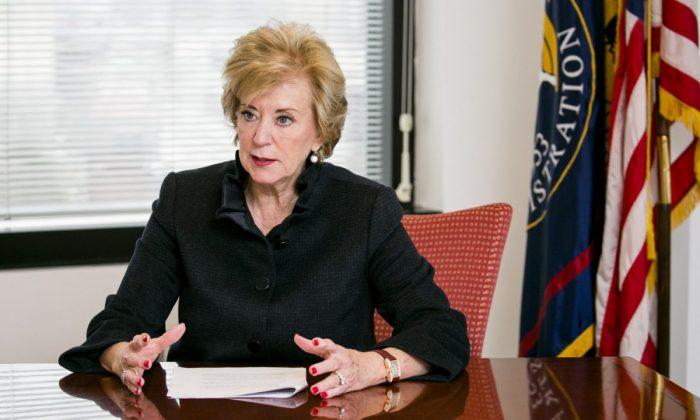WASHINGTON—Linda McMahon, administrator of the Small Business Administration, recently recounted her agency’s efforts to deal with the partial government shutdown and natural disasters.
The recent partial shutdown had limited impact on government-backed loans. In the first two weeks following the shutdown, the U.S. Small Business Administration (SBA) caught up on almost all loan applications, McMahon said.
The SBA’s lending and guarantee programs stopped for a total of 20 business days as a result of the lapse, according to the administrator. During that time, the agency was unable to approve loans and accept new loan applications.
After the resumption of operations on Jan. 28, however, the SBA has made significant progress in processing loans, McMahon said at a Senate hearing on “Oversight of the U.S. Small Business Administration,” on Feb. 13.
In just two weeks, the SBA approved more than 4,700 loans amounting to more than $2 billion. Within five days following the shutdown, the agency also processed all surety bond applications for a total of $188 million in bond guarantees.
“In all lending categories but one, our application volume is back to pre-lapse levels,” she said, adding that there was still some backlog with SBA’s 504 loans.
SBA Loan Processing Times
Since she took office, improving the SBA’s loan processing times was one of her key priorities, McMahon said.“By the end of 2018, through better procedures and electronic processing, we were able to reduce our loan processing times by half,” she said. Thanks to the new system, the SBA can now process small loans within two to three days and regular loans within seven days.
“These improvements and efficiencies have certainly helped us following the lapse,” she explained.
The SBA had one of the largest percentages of workers furloughed as a result of the recent shutdown. Nearly 2,000 employees were affected by the lapse.
SBA’s Disaster Loan Program
The SBA also provides low-interest loans under a disaster recovery program to help businesses and homeowners get back on their feet.“When I look back on the last two years, the agency’s work in responding to natural disasters stands out as an area that has touched” many states, McMahon said at the hearing.
Learning from past experiences, the SBA identified various areas that needed to operate more effectively and efficiently. To respond to the hurricane events on time, the agency recruited more people and opened recovery centers. And to improve the efficiency of its operations, the SBA launched a new version of its “disaster credit-management system,” which enabled faster loan processing.
The agency helped more than 173,000 people with home and business loans totaling $8.8 billion for the major events over the past eighteen months, including five hurricanes and the California wildfires, said McMahon.
At the hearing, ranking member of the Senate Committee on Small Business and Entrepreneurship Sen. Ben Cardin (D-Md.) praised McMahon’s efforts after the tragedies in Maryland.
“Your people were on the ground literally when the waters were still flooding. You were there immediately and provided tremendous assistance,” he said.
Besides the loan programs, SBA offices and resource partners throughout the country provide counseling, training, and mentorship programs, and most of them are free to small-business owners.
In 2019, the SBA plans to launch an innovative interactive digital platform to provide learning resources for women entrepreneurs. The agency is also launching a leadership program for Veteran entrepreneurs in conjunction with the Veterans Affairs.





